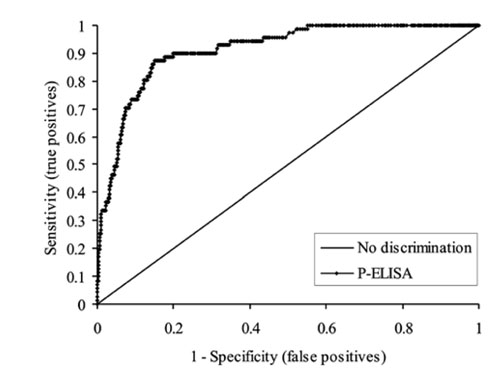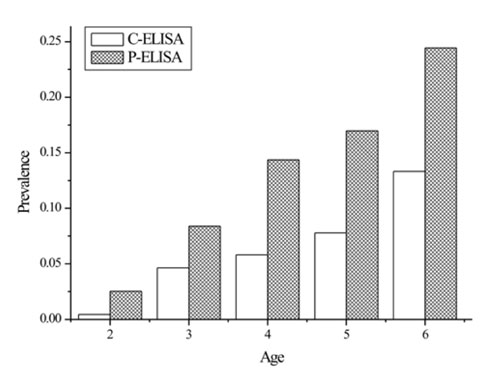J Vet Sci.
2006 Dec;7(4):349-354. 10.4142/jvs.2006.7.4.349.
Analysis of the seroprevalence of bovine paratuberculosis and the application of modified absorbed ELISA to field sample testing in Korea
- Affiliations
-
- 1Department of Microbiology, College of Veterinary Medicine, Seoul National University, Seoul 151-742, Korea. yhp@snu.ac.kr
- 2KRF Zoonotic Disease Priority Research Institute, College of Veterinary Medicine, Seoul National University, Seoul 151-742, Korea.
- 3Department of Bacteriology, National Veterinary Research and Quarantine Service, Anyang 430-824, Korea.
- 4Department of Veterinary Microbiology and Pathology, Washington State University, Pullman, WA 99164-7040, USA.
- KMID: 1089482
- DOI: http://doi.org/10.4142/jvs.2006.7.4.349
Abstract
- Paratuberculosis (PTB) is a major disease problem worldwide, and causes major economic losses in the dairy industry. Although PTB has been reported in Korea, no studies have been conducted to determine its prevalence and no program has been developed to control the disease. In this study, the sera of beef (n = 1,056) and dairy cattle (n = 1,105) from all provinces in Korea were tested to determine the prevalence of PTB using two different ELISA: an 'in house' modified absorbed ELISA (P-ELISA) based on sonicated antigen from Mycobacterium avium subsp. paratuberculosis ATCC 19698, and a commercial ELISA (C-ELISA). Receiver operating characteristic analysis was used to determine the cutoff point for P-ELISA. Based on C-ELISA results, the area under the curve for P-ELISA was 0.913 (95% CI, 0.883 to 0.943). Using a cutoff point of 0.100, P-ELISA showed a sensitivity of 62.0% and a specificity of 93.7%. The kappa value and the percent agreement between the two ELISAs were 0.322 and 92.5%, respectively. Both ELISAs showed a significant correlation between age and seropositivity (p < 0.01). According to C-ELISA, 71 of 2,161 sera (3.3%, 95 CI, 2.6% to 4.1%) were test-positive. The national true prevalence of PTB was estimated to be 7.1%. The findings suggest that a control program should be implemented to limit the spread of this disease, and that P-ELISA could be used as a screening test that produces results similar to C-ELISA.
MeSH Terms
-
Animals
Antibodies, Bacterial/blood
Cattle
Cattle Diseases/*epidemiology/*microbiology
Enzyme-Linked Immunosorbent Assay/veterinary
Female
Korea/epidemiology
Male
Mycobacterium avium subsp. paratuberculosis/*isolation & purification
Paratuberculosis/blood/*epidemiology
ROC Curve
Sensitivity and Specificity
Seroepidemiologic Studies
Figure
Reference
-
1. Adaska JM, Anderson RJ. Seroprevalence of Johne's-disease infection in dairy cattle in California, USA. Prev Vet Med. 2003. 60:255–261.
Article2. Altman DG. Practical Statistics for Medical Research. 1991. 1st ed. London: Chapman and Hall;403–409.3. Beck JR, Shultz EK. The use of relative operating characteristic (ROC) curves in test performance evaluation. Arch Pathol Lab Med. 1986. 110:13–20.4. Benedictus G, Dijkhuizen AA, Stelwagen J. Economic losses due to paratuberculosis in dairy cattle. Vet Rec. 1987. 121:142–146.
Article5. Chiodini RJ, Van Kruiningen HJ, Merkal RS. Ruminant paratuberculosis (Johne's disease): the current status and future prospects. Cornell Vet. 1984. 74:218–262.6. Colgrove GS, Thoen CO, Blackburn BO, Murphy CD. Paratuberculosis in cattle: a comparison of three serologic tests with results of fecal culture. Vet Microbiol. 1989. 19:183–187.
Article7. Collins MT, Morgan IR. Economic decision analysis model of a paratuberculosis test and cull program. J Am Vet Med Assoc. 1991. 199:1724–1729.8. Collins MT, Sockett DC, Ridge S, Cox JC. Evaluation of a commercial enzyme-linked immunosorbent assay for Johne's disease. J Clin Microbiol. 1991. 29:272–276.
Article9. Collins MT, Wells SJ, Petrini KR, Collins JE, Schultz RD, Whitlock RH. Evaluation of five antibody detection tests for diagnosis of bovine paratuberculosis. Clin Diagn Lab Immunol. 2005. 12:685–692.
Article10. Cox JC, Drane DP, Jones SL, Ridge S, Milner AR. Development and evaluation of a rapid absorbed enzyme immunoassay test for the diagnosis of Johne's disease in cattle. Aust Vet J. 1991. 68:157–160.
Article11. Dargatz DA, Byrum BA, Hennager SG, Barber LK, Kopral CA, Wagner BA, Wells SJ. Prevalence of antibodies against Mycobacterium avium subsp. paratuberculosis among beef cow-calf herds. J Am Vet Med Assoc. 2001. 219:497–501.
Article12. Ferreira R, Fonseca L, Lilenbaum W. Comparison between a commercial and an in-house ELISA for anti-M. avium paratuberculosis antibodies detection in dairy herds in Rio de Janeiro, Brazil. Rev Latinoam Microbiol. 2002. 44:129–134.13. Gasteiner J, Awad-Masalmeh M, Baumgartner W. Mycobacterium avium subsp. paratuberculosis infection in cattle in Austria, diagnosis with culture, PCR and ELISA. Vet Microbiol. 2000. 77:339–349.
Article14. Gasteiner J, Wenzl H, Fuchs K, Jark U, Baumgartner W. Serological cross-sectional study of paratuberculosis in cattle in Austria. Zentralbl Veterinarmed B. 1999. 46:457–466.
Article15. Gilot P, Coene M. Thermostable macromolecular antigens from mycobacteria. Can J Microbiol. 1994. 40:605–611.
Article16. Gilot P, Misonne MC. Mycobacterium paratuberculosis and Escherichia coli share common antigenic determinants. Vet Microbiol. 1994. 39:353–360.
Article17. Hill BB, West M, Brock KV. An estimated prevalence of Johne's disease in a subpopulation of Alabama beef cattle. J Vet Diagn Invest. 2003. 15:21–25.
Article18. Hirst HL, Garry FB, Morley PS, Salman MD, Dinsmore RP, Wagner BA, McSweeney KD, Goodell GM. Seroprevalence of Mycobacterium avium subsp paratuberculosis infection among dairy cows in Colorado and herd-level risk factors for seropositivity. J Am Vet Med Assoc. 2004. 225:97–101.
Article19. Johnson-Ifearulundu YJ, Kaneene JB, Sprecher DJ, Gardiner JC, Lloyd JW. The effect of subclinical Mycobacterium paratuberculosis infection on days open in Michigan, USA, dairy cows. Prev Vet Med. 2000. 46:171–181.
Article20. Kim D, Jeon KJ, Kim JT, Shin KS, Shin MK, Chang GH, Kim JK, Kim OS, Jung JY. Prevalence of paratuberculosis of dairy cattle in Kangwon area. Korean J Vet Res. 2002. 42:81–88.21. Kim JM, Ahn JS, Woo SR, Jo DH, Jo YS, Park JM, Yoon YD, Chang GH. A survey of paratuberculosis by immunological methods in dairy and Korean native cattle. Korean J Vet Res. 1994. 34:93–97.22. Kim TJ, Kim YS, Kim JC, Yoon WJ, Lee WC, Shin SJ, Chang YF. Studies on molecular biological and immunological diagnosis of Johne's disease. Korean J Vet Res. 1997. 37:349–358.23. Manning EJ, Collins MT. Mycobacterium avium subsp. paratuberculosis: pathogen, pathogenesis and diagnosis. Rev Sci Tech. 2001. 20:133–150.
Article24. Martin SW, Meek AH, Willeberg P. Veterinary Epidemiology: Principles and Methods. 1987. 1st ed. Ames: Iowa State University Press;62–73.25. Merkal RS, Whipple DL, Sacks JM, Snyder GR. Prevalence of Mycobacterium paratuberculosis in ileocecal lymph nodes of cattle culled in the United States. J Am Vet Med Assoc. 1987. 190:676–680.26. Meylan M, Nicolet J, Busato A, Burnens A, Martig J. The prevalence of paratuberculosis in the Plateau de Diesse region. Schweiz Arch Tierheilkd. 1995. 137:22–25.27. Milner AR, Mack WN, Coates KJ, Hill J, Gill I, Sheldrick P. The sensitivity and specificity of a modified ELISA for the diagnosis of Johne's disease from a field trial in cattle. Vet Microbiol. 1990. 25:193–198.
Article28. Ministry of Agriculture and Forestry. Agricultural and Forestry Statistical Yearbook 2002. 2002. Seoul: Ministry of Agriculture and Forestry;124–125.29. Ott SL, Wells SJ, Wagner BA. Herd-level economic losses associated with Johne's disease on US dairy operations. Prev Vet Med. 1999. 40:179–192.
Article30. Pence M, Baldwin C, Black CC 3rd. The seroprevalence of Johne's disease in Georgia beef and dairy cull cattle. J Vet Diagn Invest. 2003. 15:475–477.
Article31. Pitt DJ, Pinch DS, Janmaat A, Condron RJ. An estimate of specificity for a Johne's disease absorbed ELISA in northern Australian cattle. Aust Vet J. 2002. 80:57–60.
Article32. Roussel AJ, Libal MC, Whitlock RL, Hairgrove TB, Barling KS, Thompson JA. Prevalence of and risk factors for paratuberculosis in purebred beef cattle. J Am Vet Med Assoc. 2005. 226:773–778.
Article33. Silva E. Evaluation of an enzyme-linked immunosorbent assay in the diagnosis of bovine tuberculosis. Vet Microbiol. 2001. 78:111–117.
Article34. Sockett DC, Conrad TA, Thomas CB, Collins MT. Evaluation of four serological tests for bovine paratuberculosis. J Clin Microbiol. 1992. 30:1134–1139.
Article35. Stabel JR. Johne's disease: a hidden threat. J Dairy Sci. 1998. 81:283–288.
Article36. Whittington RJ, Hope AF, Marshall DJ, Taragel CA, Marsh I. Molecular epidemiology of Mycobacterium avium subsp. paratuberculosis: IS900 restriction fragment length polymorphism and IS1311 polymorphism analyses of isolates from animals and a human in Australia. J Clin Microbiol. 2000. 38:3240–3248.
Article37. Yokomizo Y, Yugi H, Merkal RS. A method for avoiding false-positive reactions in an enzyme-linked immunosorbent assay (ELISA) for the diagnosis of bovine paratuberculosis. Nippon Juigaku Zasshi. 1985. 47:111–119.
Article
- Full Text Links
- Actions
-
Cited
- CITED
-
- Close
- Share
- Similar articles
-
- Estimation of Paratuberculosis Prevalence in Dairy Cattle in a Province of Korea using an Enzyme-linked Immunosorbent Assay: Application of Bayesian Approach
- Immunohistochemical localization of galectin-3 in the granulomatous lesions of paratuberculosis-infected bovine intestine
- Tactics of Mycobacterium avium subsp. paratuberculosis for intracellular survival in mononuclear phagocytes
- Comparative antibody response of five recombinant antigens in related to bacterial shedding levels and development of serological diagnosis based on 35 kDa antigen for Mycobacterium avium subsp. paratuberculosis
- Evaluation of hemagglutination inhibition test for canine respiratory coronavirus antibodies and seroprevalence in Korean dogs



